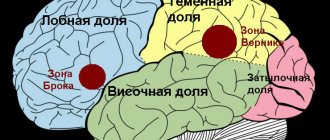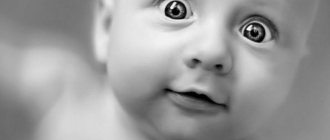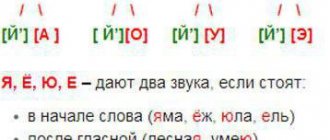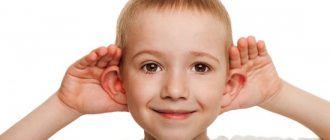What is a vowel sound?
Vowel sounds are the minimum unit of speech, which is pronounced only with the help of the voice. Ways to form vowel sounds:
- [a] let's create with the help of a wide-open mouth: rAb
; - [o] we get if we round the lips: kOt
; - [y] will appear when you stretch your lips into a tube: steering wheel
; - [and] we will hear if we stretch our lips into a smile: whale
; - [s] is formed by slightly stretched lips and a slightly pulled back tongue: сыр
; - [e] – we stretch our lips horizontally without opening our mouth wide: Echo
.
What is it needed for
I will tell you what sound-letter analysis and synthesis is - analysis of the elements of speech: syllables, words and sentences. What symbols do they consist of, how are they displayed in writing (letters) and in speaking (sounds). In other words, it is the basis of our literacy. Many parents naively believe that it is enough to learn all the letters with their child, he will immediately read and get carried away with reading books. And he will also write competently and beautifully. However, reality forces even the most dreamy romantics to take off their rose-colored glasses,
The child will learn that sentences are made up of words, words are made up of syllables, and syllables are made up of letters or sounds. And each sound is displayed on the letter using special written icons. And they are arranged in a certain sequence. If you change their sequence, then the meaning of the word will change, for example, take 3 letters T, K, O, from them you can lay out 3 words: CAT, TOK, WHO, each of which carries its own semantic load.
How many sounds can a vowel make?
Say these words, “singing” the first vowel sounds: hedgehog, pit, spinning top, spruce.
Listen to them. When pronounced, we will hear two sounds:
- [yo]zh;
- [ya]ma;
- [yu]la;
- [ye]l.
The letters E, E, Yu, I represent two sounds, because it is joined by the soft sonorant consonant Y (yot).
Compare with words: watermelon, needle, hoop, rat, equator
. Here the sounds [a], [u], [i], [o], [s], [e] are clearly pronounced. The letters A, U, Y, I, O, E have one sound.
What is sound analysis of a word? Printed consultation for parents.
Olga Gordeeva
What is sound analysis of a word? Printed consultation for parents.
WHAT IS SOUND WORD ANALYSIS ?
Sound analysis of a word is the determination of the sounds in a word in order and their characteristics (vowel - consonant, voiced - voiceless, soft hard)
The sound pattern of a word is a sequence of squares - symbols, laid out in the same order as the sounds in the word .
HOW TO PERFORM A SOUND WORD ANALYSIS WITH A CHILD ?
Sound analysis is performed by sequentially highlighting the sounds in a word and their characteristics with the .
Let's do a sound analysis of the word HOME :
1. Let’s highlight the first sound :
ddd-om - the first sound D - it is consonant , voiced, hard - let's denote it with a blue square with a bell.
2. Let’s highlight the second sound :
d - ooo - m - second sound O - he
vowel - let's denote it with a red square.
3. Let’s highlight the third sound :
to - mmm - the third sound M - it is consonant , voiced, hard - let's designate it with a blue square with a bell.
The word HOUSE has 3 sounds , 2 consonants and 1 vowel.
Consonant sounds D and M.
Vowel sound O.
Let's name the sounds in order : D O M.
Let's write the word in letters : HOUSE
SOUND ANALYSIS OF THE WORD WHALE
1. Let’s highlight the first sound :
кькь – it – the first sound Кь – consonant , unvoiced, soft, denoted by a green square.
2. Let’s highlight the second sound with our voice – kiiiit , the second sound I , Let’s denote it with a red square.
3. Let’s highlight the third sound with our voice – kittt , the third sound T , it is consonant, voiceless and hard, we’ll designate it with a blue square.
The word whale has 3 sounds : 2 consonants and 1 vowel. Consonants Кь and Т. Vowel I. Let's name the sounds in order Кь , И, Т.
TIP FOR PARENTS .
Letters denoting voiced sounds :
M, B, G, D, N, V, F, L, R, Z, J.
Letters denoting unvoiced sounds :
P, K, X, T, F, Sh, S, Ch, Shch, C.
Children determine whether a sound is voiced or unvoiced your throat rings while pronouncing a sound
-
sonorous sound . If it doesn’t ring
, he’s deaf
Letters that always denote hard sounds : Ш, Ж, Ц.
Letters that always denote soft sounds : Shch, Ch, Y.
The remaining letters can represent two sounds: hard and soft : T and T', P and P', K and K', D and D', etc.
Softness and hardness of sounds children
determine by ear:
MEL - the sound is soft .
CHALK - the sound l is hard .
CAT – the sound K is hard .
KIT - the sound K is soft .
Parents can check as follows:
If in a letter A, O, U, Y, E are written after a consonant, then it means a hard sound .
If the letters E, E, Yu, I are written after a consonant letter in a letter, then it means a soft sound .
sounds E , Ё, Yu, I; these are vowel letters that indicate the softness of a consonant in writing.
Voiced consonant sounds at the end of words in speech are deafened and replaced by paired unvoiced ones: D - T, G - K, B - P, Zh - Sh, V - F, Z - S.
We write ICE - we say [FLIGHT]
We write KNIFE - we say [NOSH]
We write SNOW - we say [SNACK]
The letters E, E, Yu, I, standing in a word after a consonant, indicate the sounds E , O, U, A,
All this must be taken into account when performing sound analysis of a word .
What are the different vowel sounds?
Types of vowel sounds are determined by position in a word:
- drums, i.e. are under stress: ud[A]r, stan[O]k, k[U]kla;
- unstressed: l[e]sa, l[i]stock, st[o]ly.
Sounds that are in the weak, i.e. unstressed position are called spellings. Their spelling depends on the rules of writing. To check, you need to place the following sounds in a strong position:
- forests - l[E]s;
- leaf - l[I]st;
- tables - st[O]l.
The sounds E, Yo, Yu, Ya do not exist in the Russian language. These letters represent the sounds [E], [O], [U], [A] after consonants:
- strap [l`amka];
- bee [bee];
- confiture [kanf`it`ur];
- hazel grouse [r`apch`ik].
Yotated sounds are pronounced with [j]:
- at the beginning of the word: skirt [yupka];
- after a vowel: sing [Paiute];
- after b and b: broth [bul'yon].
Sound-syllable analysis of words as a key to successfully mastering reading and writing skills
Yurtaeva Alina Khalimovna
Sound-syllable analysis of words as a key to successfully mastering reading and writing skills
Mom, dad, grandma, read to me! - asks a child of five or six years old. Why doesn't he want or can't read himself?
Parents often ask the question: how to teach a child to read and write?
Writing is the process of translating oral speech into a letter model, and reading is the process of moving from a graphic model of a word to its oral sound form . Parents are quite capable of teaching a 5-6 year old child to read if they do it correctly. The idea of successful learning is this: first you need to teach how to isolate sounds in a word , and then replace the sound with a letter . Conscious distinction between sounds and letters , a clear understanding of the transition from spoken speech to letter writing does not occur immediately, but if a child does not at least intuitively feel that words consist of sounds , it is difficult to teach him to read and write.
Five- and six-year-old children are already ready to learn to read and write; it will not be difficult to teach them to hear sounds and put them into words . The main thing is to do it correctly while playing. To prevent a child from confusing letters or rearranging them, it is important to teach children not just to merge letters into syllables, syllables into words , but to teach children sound (phonetic)
analysis of syllables and words .
Phonemic analysis should give the child an orientation in the sound system of the language , which will serve as the basis for mastering literacy .
Teaching literacy using the analytical-synthetic method is educational and developmental in nature: constant attention to the development of speech and conscious reading develops the thinking abilities of preschoolers.
Sound as the basis for analytical and synthetic work , and the letter is introduced as a designation for sound after becoming familiar with the sound . Hence - great attention to the isolation of sounds , sound analysis and synthesis , articulation of sounds , and the development of speech hearing.
reading unit is a syllable - a fusion of consonant and vowel sounds .
In preparation for sound-syllable analysis of words , which is the key to successfully mastering reading and writing skills , several successive stages can be distinguished:
1. Isolating the first vowel sound from the beginning of a word .
For example: DUCK, HEEH, MUSTACHE, IRON, SNAIL...
STORK, ANYA, ASTRA, ABC, AUGUST...
OLYA, WASPES, AUTUMN, LAKE, DONKEY...
2. Analysis and synthesis of reverse syllables of the type: AT, OT, UT. At the same time, children learn to isolate the last consonant sound from the end of a word .
In parallel with preparing for sound-syllable analysis, it is necessary to introduce children to the concepts of CONSONANT and VOWEL sound . Visually, by your articulation and on children, show the difference in the pronunciation of consonants and vowels. Vowels - we open our mouth wide and sing, consonants - the sound meets an obstacle (lips, teeth, tongue, we expend effort. Also, children should know the difference between a sound - we hear and pronounce it, and a letter - we write, see, read.
3. Preparation for word analysis – isolating the stressed vowel from the position after the consonant: MAK, SUP, SOK.
4. Analysis and synthesis of the direct syllable type MA.
Analysis and synthesis of words like CANCER , BALL, NOSE, TIR.
What is the 1st sound ? What's the last sound ? What's the sound in the middle ?
Or: What is the 1st sound ? What is the 2nd sound ? What is the 3rd sound ?
How many sounds are in a word ? What word did you understand ?
More difficult: Name the vowel sound in this word . Name the consonant sounds .
5. Introduction to syllabic analysis .
Syllable analysis is the next stage with the sound side of the word . The term SYLLABLE itself is introduced a little later; at the initial stages, a particle of the word . It is necessary to explain to the child that a word can consist of several parts. We invite children to listen to how some words : not as always, but by syllables (parts)
: NO-GA, WA-XIA, MA-SHI-NA...
You can use the same picture, calling it differently and each time determining the number of syllables in the word :
CAT, CAT, KITTEN, KITTEN.
What is the 1st part in this word ? What is the 2nd part in this word ? How many parts are there in total?
By performing these exercises in a playful way, the child learns in a fun, interesting way and successfully prepares for reading and writing .
Table "Vowels and sounds"
| Letters | Sounds | ||
| drums | unstressed | iotized | |
| A | [A] weasel [weasel] | [A] net [net] | _ |
| E | [E] song [p'es'n'a] | [AND] snow [sn`Iga] | [YE], [YI] Spruce [YEl`] Raccoon [YInot] |
| Yo | [ABOUT] chick [t`olka] | _ | [YO] Hedgehog [YOzhyk] |
| AND | [AND] food [p`isch`a] | [AND] saw [p'Ila] | _ |
| ABOUT | [ABOUT] cosmos [kosmas] | [A] kosmos [cosmos] | _ |
| U | [U] Duck [Duck] | [U] tangle [tangle] | _ |
| Y | [s] Crimea [crime] | [s] jump [jump] | _ |
| E | [E] Era [Era] | [E] crew [Ek`ipash] | _ |
| YU | [U] hatch [l'uk] | [U] love [l`ubof`] | [YU] Skirt [YUPKA] yuzhanka [Yuzhanka] |
| I | [A] Apple [Yablaka] | [YI] five [p`It`orka] | [YA], [YI] Yama [Yama] manifested [prayIv`il] |
Position at the beginning of a word
Then tell the baby that, for example, in the letter A there is the sound “aaa”, he stretches out, we say it with his mouth wide open. And we begin to come up with words for this sound. If the children cope with this task, we begin to complicate the task. We come up with the sound A: fruits, transport, animals, edibles. Then we check how well the skill has been mastered and name the words. And if they contain the sound you are looking for, you need to clap your hands, stamp your foot, jump, and show the card with that letter. We show several pictures, select from them those that begin with the desired sound.
Division into syllables
One option: there are 3 houses, with one window, two, three, this is the number of syllables. We will place residents there, depending on the number of syllables. To make it easier for the baby to divide into syllables, you need to hold your palm under your chin and count the number of times you open your mouth, the number of syllables. You can divide into parts by clapping your hands, but if there are problems with phonemic hearing, then the child will make mistakes. For example, the word “ceiling” will separate “po-to-lo-k”. In this case, there should be clear instructions - the syllable is only for an open mouth. And when pronouncing “k” the mouth does not open.
Finding a stressed syllable also reveals problems with the sense of language. It is necessary to show with your voice, exaggeratingly emphasizing each syllable in a word, for example, divide “milk” into syllables. Then say “milk, milk, milk”, let the child choose the correct option. A stressed syllable can be highlighted with a wave of the hand. Emphasizing this syllable with intonation and increasing volume will help lay the foundations for beautiful speech and expressive reading.
Making a diagram
After this, we introduce the child to the concept of a sentence and say that it consists of several words. For example, “Masha washes her hands,” there are 3 words in this sentence. Take 1 long strip (stick, draw a line). Then under the long strip we put 3 shorter ones, these are words, the “Masha” strip, the “washes” strip, the “hands” strip. After this, we begin to divide each word into syllables and lay out smaller strips and syllables below. For children under 5 years old this is quite enough.
Already in the preparatory group, under each syllable, squares-sounds of different colors are first laid out. Typically, vowels are red, consonants are hard blue and soft consonants are green. Below them, letters are laid out from a split alphabet. When the child has already learned to write letters, then you can lay out the sound-letter analysis scheme in reverse - draw a colored circle under each letter, divide the words into syllables, highlighting the stressed vowel.
You don’t have to write the letters, but use a magnetic alphabet, cubes, cards and other materials at hand. This is the case if fine motor skills are poorly developed and it is difficult for the baby to write. And he already knows the letters well. And thus, separate the development of fingers and phonetic analysis for a while and combine these skills later as the hand develops. In any case, we need to look at the child’s zones of proximal development. See what he can do on his own, and what he can do only together with you.
I’ll finish writing here, because the topic is very broad and it is impossible to cover it in one article. I hope there will be a whole series, because this is the basis of the work of a speech therapist. So stay tuned for blog updates and subscribe. Write in the comments about your experience, share on social networks with friends and acquaintances.
What does the word end with?
When this skill is mastered, we find the sound at the end of the word. The order is the same as with the position at the beginning of a word. But you can include the game in a chain of words, the next word should begin with the sound with which the previous one ends (onion - braid - pineapple - juice). And you can differentiate, divide words into those where the sound is at the beginning of the word, and where at the end. Arrange the pictures into two piles, for example, “beak” and “tail”. Raise your left hand, then your right, jump or sit down, raise your hands up, lower them down, etc., etc.
Sound in the middle of a word
Then the position in the middle of the word comes into play; it is the most difficult, especially for those children whose phonemic hearing is particularly impaired. They do not hear the vowels in the middle of the word and also write: “the road is a road,” “milk is milk.” We work according to the above scheme. Then we connect 3 positions, 3 different actions. We arrange the pictures into 3 piles “beak”, “tail”, “wings”. Or we traditionally put you on the train - the 1st, 2nd and 3rd carriages, respectively. And here you can simultaneously divide words into syllables and find the stressed vowel.
Word phonetic analysis plan
The phonetic analysis of each word is not carried out randomly, but according to a specific plan.
- The orthographically correct spelling of the word is indicated.
- The word form is divided into syllables and the stress is indicated.
- The place of possible transfer of parts of the word is determined.
- The word is written as it is pronounced - in transcription.
- A sequential description of all sounds of the word is given.
- The number of letters and phonemes, cases of discrepancy between letters and sounds are indicated.
- A color scheme of the parsed word is created.





